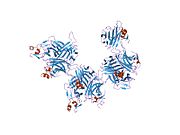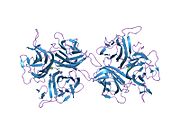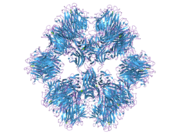Faktor aktivacije B-ćelija
| edit |
Faktor aktivacije B-ćelija, (BAFF) koji je takođe poznat kao faktor nekroze tumora ligand superfamilija član 13B, je protein koji je kod ljudi kodiran genom TNFLSF13B.[1][2] BAFF je isto tako poznat kao B limfocit stimulator (BLyS), TNF-, APOL-srodni leukocit izražen ligand (TALL-1), i TNF-sličan molekul iz dendritskih ćelija (CD257 antigen; klaster diferencijacije 257).
BAFF je citokin iz TNF ligand familije. Ovaj citokin je ligand za receptore TNFRSF13B/TACI, TNFRSF17/BCMA, i TNFRSF13C/BAFFR. Ovaj citokin je izražen u B ćelijskoj lozi ćelija, i on dejstvuje kao potentan B ćelijski aktivator. Za njega je bilo pokazano da igra važnu ulogu u proliferaciji i diferencijaciji B ćelija.[3]
BAFF je 285-aminokiseline dugačak peptidni glikoprotein podleže glikozilaciji na ostatku 124. On je izražen kao transmembranski protein na različitim ćelijskim tipovima, kao što su monociti, dendritske ćelije i ćelije koštane srži. Transmembranska forma može biti odvojena od membrane, čime se generiše rastvorni proteinski fragment. BAFF je prirodni ligand tri neuobičajena receptora faktora nekroze tumor koji se zovu BAFF-R, TACI, i BCMA. Ova tri receptora imaju različite afinitete vezivanja za BAFF. Ovi receptori su izraženi uglavnom na formiranim B limfocitima (TACI se takođe nalazi na podskupu T-ćelija i BCMA na plazma ćelijama). TACI se najslabije vezuje pošto je njegov afinitet veći za slični protein koji se zove A proliferacija indukujući ligand (APRIL). BCMA pokazuje intermedijarno vezujući fenotip i može da interagujeu promenljivim stepenima bilo sa BAFF ili APRIL. Signalizacija kroz BAFF-R i BCMA stimuliše B limfocite da se proliferiraju i da se suprotstave apoptozi. Svi ovi ligandi dejstvuju kao heterotrimeri koji interaguju sa heterotrimerskim receptorima[4], mada je za BAFF poznato da može da bude aktivan kao bilo hetero- ili homotrimer.[5][6]
Za B-ćelijski aktivirajući faktor je bilo pokazano da interaguje sa TNFRSF13B,[7][8] TNFSF13[9] i TNFRSF17.[10][11]
Belimumab (Benlysta) je monoklonalno antitelo koje je razvila kompanija Ljudske genomske nauke (engl. Human Genome Sciences) koje specifično prepoznaje i inhibira biološku aktivnost B-limfocit stimulatora (BLyS) i ono je u kliničkim ispitivanjima za tretman Sistemske lupus eritematoze i drugih auto-imunih oboljenje.
- ↑ Shu HB, Hu WH, Johnson H (May 1999). „TALL-1 is a novel member of the TNF family that is down-regulated by mitogens”. J. Leukoc. Biol. 65 (5): 680–3. PMID 10331498.
- ↑ Schneider P, MacKay F, Steiner V, Hofmann K, Bodmer JL, Holler N, Ambrose C, Lawton P, Bixler S, Acha-Orbea H, Valmori D, Romero P, Werner-Favre C, Zubler RH, Browning JL, Tschopp J (June 1999). „BAFF, a novel ligand of the tumor necrosis factor family, stimulates B cell growth”. J. Exp. Med. 189 (11): 1747–56. DOI:10.1084/jem.189.11.1747. PMC 2193079. PMID 10359578.
- ↑ „Entrez Gene: tumor necrosis factor (ligand) superfamily”.
- ↑ Oren,D.A., Li,Y., Volovik,Y., Morris,T.S., Dharia,C., Das,K., Galperina,O., Gentz,R. and Arnold,E. (2002). „Structural basis of BLyS receptor recognition”. Nat. Struct. Biol. 9 (4): 288–292. DOI:10.1038/nsb769. PMID 11862220.
- ↑ Daridon C, Youinou P, Pers JO (February 2008). „BAFF, APRIL, TWE-PRIL: who's who?”. Autoimmun Rev 7 (4): 267–71. DOI:10.1016/j.autrev.2007.05.002. PMID 18295728.
- ↑ Mire-Sluis, Anthony R.; Thorpe, Robin, ur. (1998). Cytokines (Handbook of Immunopharmacology). Boston: Academic Press. ISBN 0-12-498340-5.
- ↑ Wu Y, Bressette D, Carrell JA, Kaufman T, Feng P, Taylor K, Gan Y, Cho YH, Garcia AD, Gollatz E, Dimke D, LaFleur D, Migone TS, Nardelli B, Wei P, Ruben SM, Ullrich SJ, Olsen HS, Kanakaraj P, Moore PA, Baker KP (November 2000). „Tumor necrosis factor (TNF) receptor superfamily member TACI is a high affinity receptor for TNF family members APRIL and BLyS”. J. Biol. Chem. 275 (45): 35478–85. DOI:10.1074/jbc.M005224200. PMID 10956646.
- ↑ Xia XZ, Treanor J, Senaldi G, Khare SD, Boone T, Kelley M, Theill LE, Colombero A, Solovyev I, Lee F, McCabe S, Elliott R, Miner K, Hawkins N, Guo J, Stolina M, Yu G, Wang J, Delaney J, Meng SY, Boyle WJ, Hsu H (July 2000). „TACI is a TRAF-interacting receptor for TALL-1, a tumor necrosis factor family member involved in B cell regulation”. J. Exp. Med. 192 (1): 137–43. DOI:10.1084/jem.192.1.137. PMC 1887716. PMID 10880535.
- ↑ Roschke V, Sosnovtseva S, Ward CD, Hong JS, Smith R, Albert V, Stohl W, Baker KP, Ullrich S, Nardelli B, Hilbert DM, Migone TS (October 2002). „BLyS and APRIL form biologically active heterotrimers that are expressed in patients with systemic immune-based rheumatic diseases”. J. Immunol. 169 (8): 4314–21. PMID 12370363.
- ↑ Liu Y, Hong X, Kappler J, Jiang L, Zhang R, Xu L, Pan CH, Martin WE, Murphy RC, Shu HB, Dai S, Zhang G (May 2003). „Ligand-receptor binding revealed by the TNF family member TALL-1”. Nature 423 (6935): 49–56. DOI:10.1038/nature01543. PMID 12721620.
- ↑ Shu HB, Johnson H (August 2000). „B cell maturation protein is a receptor for the tumor necrosis factor family member TALL-1”. Proc. Natl. Acad. Sci. U.S.A. 97 (16): 9156–61. DOI:10.1073/pnas.160213497. PMC 16838. PMID 10908663.
- Nardelli B, Moore PA, Li Y, Hilbert DM (2003). „B lymphocyte stimulator (BLyS): a therapeutic trichotomy for the treatment of B lymphocyte diseases.”. Leuk. Lymphoma 43 (7): 1367–73. DOI:10.1080/10428190290033297. PMID 12389615.
- Zhou T, Zhang J, Carter R, Kimberly R (2003). „BLyS and B cell autoimmunity.”. Curr. Dir. Autoimmun. 6: 21–37. DOI:10.1159/000066854. PMID 12408045.
- Stohl W (2005). „A therapeutic role for BLyS antagonists.”. Lupus 13 (5): 317–22. DOI:10.1191/0961203304lu1019oa. PMID 15230285.
- Quartuccio L, Fabris M, Ferraccioli G (2004). „[B lymphocyte stimulator (BLyS) and monocytes: possible role in autoimmune diseases with a particular reference to rheumatoid arthritis]”. Reumatismo 56 (3): 143–6. PMID 15470519.
- Sutherland AP, Mackay F, Mackay CR (2007). „Targeting BAFF: immunomodulation for autoimmune diseases and lymphomas.”. Pharmacol. Ther. 112 (3): 774–86. DOI:10.1016/j.pharmthera.2006.06.002. PMID 16863659.
- Bossen C, Schneider P (2007). „BAFF, APRIL and their receptors: structure, function and signaling.”. Semin. Immunol. 18 (5): 263–75. DOI:10.1016/j.smim.2006.04.006. PMID 16914324.
- Brink R (2007). „Regulation of B cell self-tolerance by BAFF.”. Semin. Immunol. 18 (5): 276–83. DOI:10.1016/j.smim.2006.04.003. PMID 16916609.
- Tangye SG, Bryant VL, Cuss AK, Good KL (2007). „BAFF, APRIL and human B cell disorders.”. Semin. Immunol. 18 (5): 305–17. DOI:10.1016/j.smim.2006.04.004. PMID 16916610.
- Treml LS, Crowley JE, Cancro MP (2007). „BLyS receptor signatures resolve homeostatically independent compartments among naïve and antigen-experienced B cells.”. Semin. Immunol. 18 (5): 297–304. DOI:10.1016/j.smim.2006.07.001. PMID 16919470.
- Woodland RT, Schmidt MR, Thompson CB (2007). „BLyS and B cell homeostasis.”. Semin. Immunol. 18 (5): 318–26. DOI:10.1016/j.smim.2006.06.001. PMID 16931037.
- Kalled SL (2007). „Impact of the BAFF/BR3 axis on B cell survival, germinal center maintenance and antibody production.”. Semin. Immunol. 18 (5): 290–6. DOI:10.1016/j.smim.2006.06.002. PMID 16931038.
- Mackay F, Leung H (2007). „The role of the BAFF/APRIL system on T cell function.”. Semin. Immunol. 18 (5): 284–9. DOI:10.1016/j.smim.2006.04.005. PMID 16931039.
- Bosello S, Pers JO, Rochas C, et al. (2007). „BAFF and rheumatic autoimmune disorders: implications for disease management and therapy.”. International journal of immunopathology and pharmacology 20 (1): 1–8. PMID 17346422.
- Mukhopadhyay A, Ni J, Zhai Y, et al. (1999). „Identification and characterization of a novel cytokine, THANK, a TNF homologue that activates apoptosis, nuclear factor-kappaB, and c-Jun NH2-terminal kinase.”. J. Biol. Chem. 274 (23): 15978–81. DOI:10.1074/jbc.274.23.15978. PMID 10347144.
- Moore PA, Belvedere O, Orr A, et al. (1999). „BLyS: member of the tumor necrosis factor family and B lymphocyte stimulator.”. Science 285 (5425): 260–3. DOI:10.1126/science.285.5425.260. PMID 10398604.
- Tribouley C, Wallroth M, Chan V, et al. (2000). „Characterization of a new member of the TNF family expressed on antigen presenting cells.”. Biol. Chem. 380 (12): 1443–7. DOI:10.1515/BC.1999.186. PMID 10661873.
- Gross JA, Johnston J, Mudri S, et al. (2000). „TACI and BCMA are receptors for a TNF homologue implicated in B-cell autoimmune disease.”. Nature 404 (6781): 995–9. DOI:10.1038/35010115. PMID 10801128.
- Shu HB, Johnson H (2000). „B cell maturation protein is a receptor for the tumor necrosis factor family member TALL-1.”. Proc. Natl. Acad. Sci. U.S.A. 97 (16): 9156–61. DOI:10.1073/pnas.160213497. PMC 16838. PMID 10908663.







